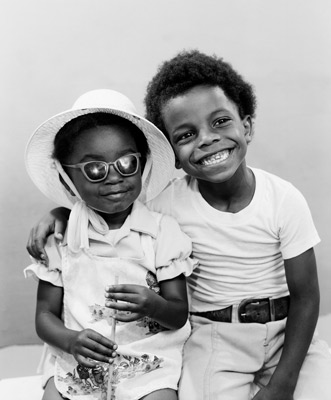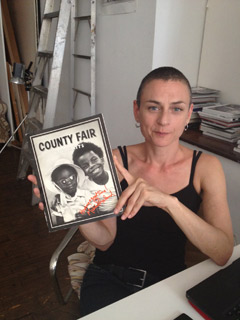 The photographer's favourite children's portrait © Mikkel Aaland
The photographer's favourite children's portrait © Mikkel AalandI met the delightful, exuberant photographer Mikkel Aaland at the Nordic Light Festival in Kristiansund, Norway, where he MC'ed, and moderated, and enlightened us as to his multi-faceted life in San Francisco.
Mikkel was showing prints from this portfolio one afternoon and I fell in love with the series. The book "County Fair: Portraits" was originally published in 1981; a Special Portfolio Edition is out now.
"My association with Harold Foote, the owner of the studio, began in 1971 when I went to the Pleasanton fair with two schoolmates in search of summer work. Foote had just pulled his studio onto the grounds and was busy setting up. He asked if any of us had photography experience. He noticed my slender frame and said, "You fit in the darkroom. A dollar-sixty-five an hour and the job is yours." The darkroom then was a dingy closet and there my career began. Two weeks later when the fair ended, Harold asked if I wanted to go on the road as a darkroom person and I agreed. Three years later I moved out of the darkroom and became a shooter and began this collection in 1976.
These portraits were made in a portable studio that was hauled from fair to fair between 1976 and 1980. The studio was complete with darkroom and a shooting stage and it took a crew of three to run it: a shooter (me), a front person to handle customers and a darkroom person to develop and print the 4x5 inch negative. The entire process, when going smoothly, took about fifteen minutes.
The studio, a weather-beaten structure of wood and steel, was mounted on a trailer and covered with peeling orange, black and white paint. At a fair we disguised it as best we could with some of our most glamorous photos-smiling faces and beauty queens. The shooting stage was just inside a heavy orange curtain which only partially blocked out the roar of the fair. A 4x5 wood box Burke & James camera was mounted on a rigid turret, its 135 mm lens so old and scratched that our pictures came out happily softened, a quality I could never achieve with a newer lens. For lighting we installed three Honeywell strobes around the room and a flood lamp above the camera. We painted the background neutral gray. Our only props were three stools and a table for infants.
Because our prices were so reasonable, we often had lines of customers that lasted from ten in the morning to midnight. To give you an idea of our volume: on a busy day in Pleasanton, I shot over 450 portraits, averaging three people per print, meaning 1,350 mostly smiling faces.
Customers generally posed themselves. I directed them to the camera and tried not to interfere with their moods, unless a mother insisted that I make her kid smile. Most of the time I only clicked the Packard shutter once, provided the subject sat sill. The shutter speed was 1/30 of a second, which doesn't stop even a slow motion. I spent a couple minutes with each customer, but large families and fussy babies took longer. After I exposed the negative, the customer paid and I sent the film holder back to the darkroom with a color coded ticket, which told the crew what size and quantity to print.
The darkroom stood behind the shooting area, through a door stained with photo chemicals. It was divided into two rooms with space for four people, though we usually worked two at a time. On one side was the small negative processing room secured from the printing area by a black curtain. The negative was processed in the normal manner, although we heated our developer to 92 degrees F and cooked the Ilford film for a brief forty seconds. Ilford was the only film we could work with; the others disintegrated at the high temperature.
The developed and fixed negative was then shoved through a small opening to the print room where a second person dipped it into a solution of Photo-Flo and squeegeed off the excess. The still-damp negative then went to one of our two Omega D-II enlargers, one for wallet-sized prints and the other for larger sizes up to 16x20 inches.
Since there was not time for guess work the exposure was determined by a densitometer. Once exposed, the paper was placed face-up in a Kreomatic processor which developed, fixed, washed and dried the print in about four minutes. This machine was a luxury we only recently acquired. Before, we had four messy, open tanks which explains why our trailers' frame was so eroded by acid and fix.
The entire procedure, from negative to finished print went smoothly most of the time. Only when we at our busiest did blunders from inexperienced help, power blackouts, electrical shorts, contaminated chemicals, scratched negatives and a host of other disasters seem to occur.
We slept in cheap motels, on cots in campgrounds, in our cars, and often in the back of a 1966 Dodge stock truck. Inside its aluminum shell we installed three bunks, two closets, a refrigerator and an air-conditioner. Chemicals and photographic paper were stored separately up front. We parked the truck on the fairgrounds near the studio. It was convenient to sleep within walking distance, particularly after a fourteen-hour workday.
During those years with Foote I shoot nearly 60,000 portraits. Of those I saved 700 negatives, 25 of which make up this portfolio."
View the full screen magazine photo feature.

